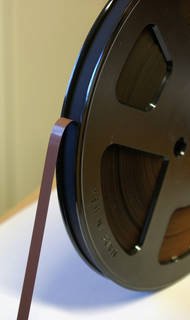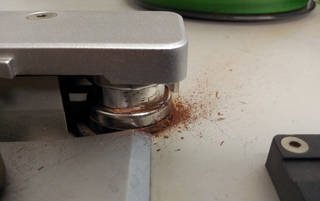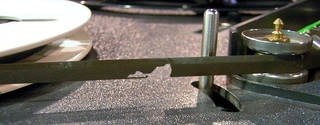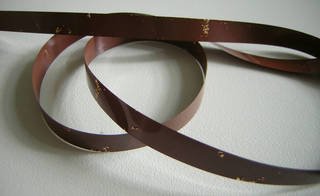This is an article provided by The University of Illinois at Urbana-Champaign to help provide how to determine if a tape might have an issue.
Magnetic Tape Binder Breakdown
a.k.a. Polyurethane Binder Deterioration (Sticky Shed Syndrome / Soft Binder Syndrome)
The material that binds magnetic particles to a base tape film is called the binder. Other than a degrading acetate base, the polyurethane binder is often considered the weakest link when it comes to magnetic tapes due to an inherent vice broadly referred to as “Soft Binder Syndrome” or, more specifically, as “Sticky Shed Syndrome” if the signal is salvageable. Though from the late 1960s through the late 1970s polyurethane binders were employed with polyester magnetic tapes, tapes from the early 1970s through the early 1980s are especially at risk. Binder breakdown will harm not only the recorded media but your playback equipment as well.
NOTE: Each of the degradation forms detailed below are precipitated by one or more of the following: original tape formula, batch variations, and cumulative storage conditions (temperature, humidity, pollution, etc.).
- Soft Binder Syndrome (SBS): Richard Hess recommends this inclusive term be used for “all tapes that show stickiness, shedding, and/or squealing, whether they respond to baking or not.” This category can include tapes with Sticky Shed Syndrome and with what in the past has (incorrectly) been referred to as Loss of Lubricant. Tapes with advanced SBS will audibly squeal on playback.
- Sticky Shed Syndrome (SSS): A subclass of Soft Binder Syndrome that is treatable through “baking” (see Solutions below). The most common form of binder breakdown, SSS-affected tapes leave a dark, gummy residue on playback. Hess posits that SSS occurs only on back-coated tapes. The shed residue comes from both the binder and the back coating. It is best to attempt to identify SSS before trying playback (see Identification). Playing a tape with advanced SSS can strip the mag coat off the base film. If in doubt, it is safer to bake a potential SSS tape than to play it (Hess, 2012).
- Loss of Lubricant (LoL): An outmoded but still useful term for a form of SBS not fully understood, but now considered a misnomer as lubricant loss is not actually to blame (Hess, 2008). The major distinction between LoL and SSS is that the former does not react to incubation. Do not bake tapes identified as having LoL.
Identification
Test for Sticky Shed Syndrome BEFORE attempting playback. To do this, slowly turn the reel and watch to see whether the tape unspools naturally from the pack or whether it sticks/lingers on the pack. The affected tape surface may exhibit a soft and gummy quality, and, on playback, will leave a dark brown residue on tape player components; this is a result of binder and back coating shedding. Do not subject an SSS-affected tape to playback.
Most tapes with SBS will make an audible squealing sound during playback. Other telltale signs of SBS may include jerky and/or slowed tape movement during playback. At its worst, binder breakdown will prevent playback or cause tapes to distort due to high tension from playback. On direct inspection, simple SBS tapes will not shed or produce gummy residue to the extent that Sticky Shed Syndrome tapes typically do.
Soft Binder Syndrome: Well-known manufacturers and types
- Ampex/Quantegy 406, 407, 456, 457
- Capitol Q15
- Melody 169*
- Pyral* unknown
- Scotch/3M 206, 207, 226, 227, 806, 807, 808, 809, 175*
- Sony PR-150,* SLH, ULH
Lists of known tape types are incomplete. Compiled from Hess, 2008; Casey, 2007.
* Considered to behave as SBS, not SSS; not treatable through incubation.
Cause
The polyurethane binder absorbs moisture from a humid environment through a chemical process called hydrolysis. The water molecules absorbed then cause the urethane to migrate to the tape surface, resulting in the aforementioned fatal errors that can hinder or even prohibit playback.
Solutions
A recovery method for tapes of the sticky shed variety has been to remove moisture from the binder by applying low heat to the tape for several hours (8+). “Baking” the tape can be destructive, and it is best done by a professional AV conservator or technician using a highly precise oven. (Media Preserve highly recommends no baking be done but a cold chemical safety process be done instead.) Baking is only a temporary fix; but, “If “ successful, it allows normal playback (without SBS defects) for weeks or months before reverting and becoming unplayable. In this time, one may easily transfer the recording to a stable format. Do not bake acetate tapes or tapes exhibiting lubricant loss (i.e. white residue).
A less risky, but far less immediate method of hydrolysis reversal is environmental conditioning. Simply place the tape in a low humidity environment—and wait for however long it takes for the effects of hydrolysis to recede.
Resources
- Hess, R. (2008). Tape degradation factors and challenges in predicting tape life. ARSC (Association for Recorded Sound Collections) Journal, 39(2), 240-274. Retrieved from: http://www.richardhess.com/tape/history/HESS_Tape_Degradation_ARSC_Journal_39-2.pdf
- Hess, R. (2012). Restoration tips & notes: Degrading tapes [blog post]. Retrieved from: http://richardhess.com/notes/formats/magnetic-media/magnetic-tapes/analog-audio/degrading-tapes/
- Casey, M. (2007). FACET: Format characteristics and preservation problems. Bloomington, IN: Indiana University. Retrieved from: http://www.dlib.indiana.edu/projects/sounddirections/facet/facet_formats.pdf





